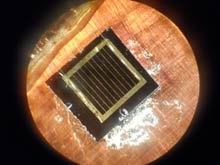
Prototype cell: This small solar cell features a semiconductor material designed to absorb more of the solar spectrum.
The most efficient solar cells typically have several layers of semiconductor materials, each tuned to convert different colors of light into electricity. Researchers at Lawrence Berkeley National Lab have now made a single semiconductor that performs almost the same job. More importantly, they made the material using a common manufacturing technique, suggesting it could be made relatively inexpensively.
Several research groups are developing semiconductor materials that harness more of the energy in sunlight, based on an idea that dates back to 1960 for changing how semiconductor materials in solar cells interact with light. But the materials used in that research tend to be very difficult to make.
Much work remains before the Lawrence Berkeley lab material could be used in a practical solar cell, but in theory it could convert nearly half of the energy in sunlight into electricity—three times as much as most single-layer (or single-junction) solar cells. Such a solar cell could also cost less than the layered (or multi-junction) solar cells currently needed to achieve high efficiencies, since it would require only one semiconductor material.
In a conventional semiconductor material, it takes a certain amount of energy to free an electron and generate electricity. Photons that have less energy—say, the photons in infrared light—don’t generate electricity. And if a photon has more than the minimum—for instance a photon in energetic ultraviolet light—the extra energy is wasted as heat.
The new semiconductor material is based on gallium arsenide. Normally, this material requires high-energy photons to generate electricity. But the researchers modified it so that the energy from more than one photon is used to free an electron—energy adds up until an electron is freed. Replacing some of the arsenic atoms in the material with nitrogen atoms creates regions that act as stepping stones for electrons that have absorbed some energy from low-energy photons, where they can wait to receive energy from more photons, says Wladek Walukiewicz, who leads the Solar Energy Materials Research Group at the Lawrence Berkeley lab, and also led the project.
Source:MIT



 留言列表
留言列表